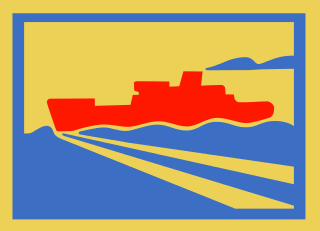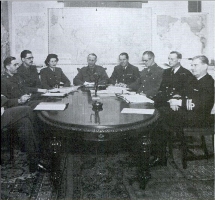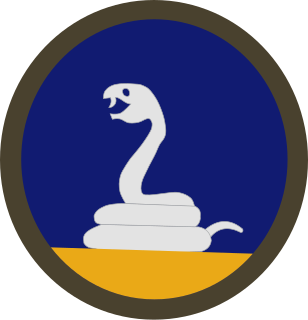
Operation Fortitude was the code name for a World War II military deception employed by the Allied nations as part of an overall deception strategy during the build-up to the 1944 Normandy landings. Fortitude was divided into two sub-plans, North and South, with the aim of misleading the German High Command as to the location of the invasion.

Operation Bodyguard was the code name for a World War II deception plan employed by the Allied states before the 1944 invasion of northwest Europe. The plan was intended to mislead the German high command as to the time and place of the invasion. The plan contained several operations, and culminated in the tactical surprise over the Germans during the Normandy landings on 6 June 1944 (D-Day) and delayed German reinforcements to the region for some time afterwards.

Operation Quicksilver was a military deception operation performed during the Second World War. Undertaken by the Allies in 1944, the operation threatened an invasion of France in the Pas de Calais region through the simulation of a large Field Army in South East England. Quicksilver formed part of the Operation Fortitude deception, itself part of the strategic Operation Bodyguard plan. The key element of Quicksilver was to convince the Germans that "First United States Army Group" (FUSAG) commanded by General George Patton would land in the Pas-de-Calais for the major invasion of Europe, after the landings in Normandy had lured the German defenders to that front.

Operation Copperhead was a small military deception operation run by the British during the Second World War. It formed part of Operation Bodyguard, the cover plan for the invasion of Normandy in 1944, and was intended to mislead German intelligence as to the location of General Bernard Montgomery. The operation was conceived by Dudley Clarke in early 1944 after he watched the film Five Graves to Cairo. Following the war M. E. Clifton James wrote a book about the operation, I Was Monty's Double. It was later adapted into a film, with James in the lead role.

Operation Zeppelin was a major military deception operation run by the British during the Second World War. It formed part of Operation Bodyguard, the cover plan for the invasion of Normandy in 1944, and was intended to mislead German intelligence as to the Allied invasion plans in the Mediterranean theatre that year. The operation was planned by 'A' Force and implemented by means of visual deception and misinformation.

Operation Titanic was a series of military deceptions carried out by the Allied Nations during the Second World War. The operation formed part of Operation Bodyguard, the cover plan for the Normandy landings in 1944. Titanic was carried out on 5–6 June 1944 by the Royal Air Force and the Special Air Service. The objective of the operation was to drop 500 dummy parachutists in places other than the real Normandy drop zones, to deceive the German defenders into believing that a large force had landed, drawing their troops away from the beachheads and strategic sites such as Caen.

First United States Army Group was a fictitious Allied Army Group in World War II prior to D-Day, part of Operation Quicksilver, created to deceive the Germans about where the Allies would land in France. To attract Axis attention, prominent US general George S. Patton was placed in command of the fabricated formation.

The 80th Infantry (Reserve) Division was an infantry division of the British Army formed at the beginning of 1943, during the Second World War. For the twenty months that the division existed, it was a training formation. It was made responsible for providing final tactical and field training to soldiers who had already passed their initial training. After five additional weeks of training, the soldiers would be posted to fighting formations overseas. Notably, the division was used as a source of reinforcements for the 21st Army Group, which was fighting in Normandy. After all available troops left the United Kingdom for France, the division was disbanded.

The London Controlling Section (LCS) was a British secret department established in September 1941, under Oliver Stanley, with a mandate to coordinate Allied strategic military deception during World War II. The LCS was formed within the Joint Planning Staff at the offices of the War Cabinet, which was presided over by Winston Churchill as Prime Minister.
Lieutenant-Colonel Roger Fleetwood Hesketh, born Roger Bibby-Hesketh, was a Conservative Party politician in the United Kingdom. He was Member of Parliament (MP) for Southport from 1952 to 1959.

Operations Taxable, Glimmer and Big Drum were tactical military deceptions conducted on 6 June 1944 in support of the Allied landings in Normandy. The operations formed the naval component of Operation Bodyguard, a wider series of tactical and strategic deceptions surrounding the invasion.
During World War II the British Army made extensive use of fictional army formations, as part of strategic or tactical military deceptions. Their use was pioneered by Dudley Clarke during the North African campaign. Clarke eventually formulated an elaborate order of battle deception to mislead the Axis high command as to the strength of Allied forces in the region. Based on these successes the London Controlling Section made extensive use of notional formations during Operation Bodyguard - a deception operation ahead of the June 1944 Normandy Landings.

The US 59th Infantry Division was a 'Phantom Division' created in May 1944 as part of Fortitude South II. to cover the deployment of the US 35th Infantry Division to Normandy.
Ops (B) was an Allied military deception planning department, based in the United Kingdom, during the Second World War. It was set up under Colonel Jervis-Read in April 1943 as a department of Chief of Staff to the Supreme Allied Commander (COSSAC), an operational planning department with a focus on western Europe. That year, Allied high command had decided that the main Allied thrust would be in southern Europe, and Ops (B) was tasked with tying down German forces on the west coast in general, and drawing out the Luftwaffe in particular.
The US XXXVII Corps was a 'Phantom Unit' created in 1944 as part of Fortitude South II, a military deception by the Allied nations during the build-up to the 1944 Normandy landings.
Colonel Harry Noel Havelock Wild OBE was a British Army officer during the Second World War. He is notable for being second in command of the deception organisation 'A' Force and well as head of Ops. B. He was educated at Eton College.

Operation Graffham was a military deception employed by the Allies during the Second World War. It formed part of Operation Bodyguard, a broad strategic deception designed to disguise the imminent Allied invasion of Normandy. Graffham provided political support to the visual and wireless deception of Operation Fortitude North. These operations together created a fictional threat to Norway during the summer of 1944.

Operation Royal Flush was a military deception employed by the Allied Nations during the Second World War as part of the strategic deception Operation Bodyguard. Royal Flush was a political deception which expanded on the efforts of another Bodyguard deception, Operation Graffham, by emphasising the threat to Norway. It also lent support to parts of Operation Zeppelin via subtle diplomatic overtures to Spain and Turkey. The idea was that information from these neutral countries would filter back to the Abwehr. Planned in April 1944 by Ronald Wingate, Royal Flush was executed throughout June by various Allied ambassadors to the neutral states. During implementation the plan was revised several times to be less extreme in its diplomatic demands. Information from neutral embassies was not well trusted by the Abwehr; as a result, Royal Flush had limited impact on German plans through 1944.

Operation Ferdinand was a military deception employed by the Allies during the Second World War. It formed part of Operation Bodyguard, a major strategic deception intended to misdirect and confuse German high command about Allied invasion plans during 1944. Ferdinand consisted of strategic and tactical deceptions intended to draw attention away from the Operation Dragoon landing areas in southern France by threatening an invasion of Genoa in Italy. Planned by Eugene Sweeney in June and July 1944 and operated until early September, it has been described as "quite the most successful of 'A' Force's strategic deceptions". It helped the Allies achieve complete tactical surprise in their landings and pinned down German troops in the Genoa region until late July.







